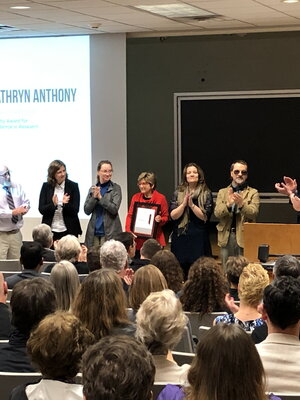
Professor Kathryn Anthony received the 2018-19 Faculty Award for Excellence in Research from the College of Fine & Applied Arts at the University of Illinois at Urbana-Champaign. The award was announced at the annual spring meeting of the College faculty on May 2, 2019. This award recognizes a faculty member who has amassed a distinguished record of research and creative work, as demonstrated through publications, performances, or exhibitions; distinguished fellowships; successful grant applications; and invited presentations or performances. Only one faculty member receives this award each year.
This capped off an exciting spring during which Professor Anthony was recently hosted by two Ivy League schools, Princeton and Cornell, and also had a chance to visit her alma mater, University of California at Berkeley.
At Cornell University on April 23, 2019, Professor Anthony delivered the annual Hillier Lecture at the awards ceremony for the Dept. of Design and Environmental Analysis. Her presentation featured her recent book, Defined by Design: The Surprising Power of Hidden Gender, Age, and Body Bias in Everyday Products and Places,https://www.penguinrandomhouse.com/books/552120/defined-by-design-by-kathryn-h-anthony/9781633882836/ and reflected on her 38-year career teaching, researching, and writing about design.
At Princeton University on March 29, 2019, she and her colleague, Dean Carla Jackson Bell of the Robert R. Taylor School of Architecture and Construction Science at Tuskegee University, were invited to present and discuss their film trailer, "Documenting Invisible Voices in Architecture (DIVA)," featuring their videotaped interviews with three African American women architects: Norma Merrick Sklarek, Sharon Sutton, and Allison Williams. The conference, "Redefining Public: Norma Merrick Sklarek", organized by Women in Design and Architecture at Princeton, focused on the life and work of this pioneering African American architect who broke countless gender and racial barriers and left a lasting architectural legacy.